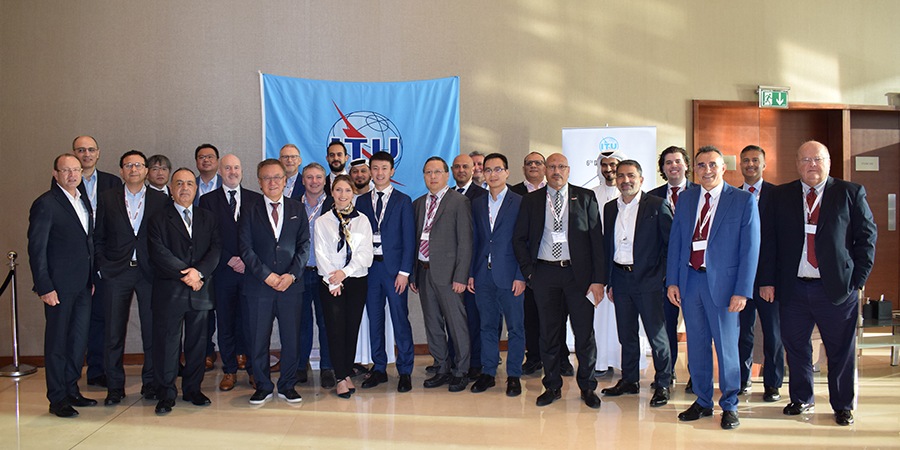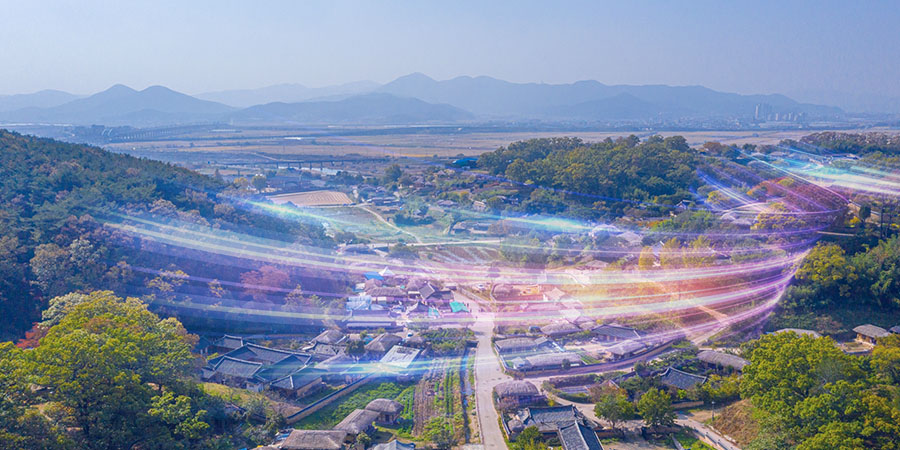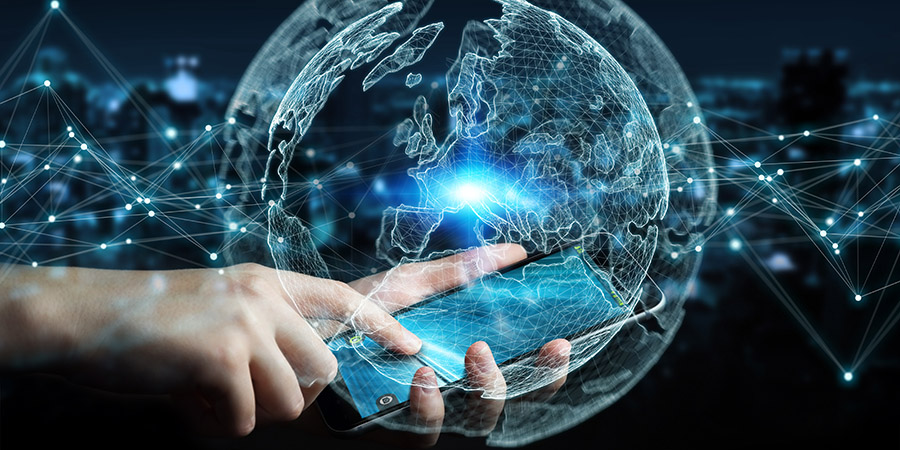Telecom Review, in collaboration with du, hosted the 6th International Telecommunication Union (ITU) CxO meeting on December 6 at the Intercontinental Dubai. The hybrid meeting saw participation from TDRA, du, Huawei, Nokia, China Telecom, TELUS, ZTE, Orange, Senko, Rohde & Schwartz, APTelecom, Arab ICT Organization, IBM, and Sofrecom.
In his welcome note, Dr. Chaesub Lee, ITU TSB director, thanked Telecom Review CEO Toni Eid, TDRA and du for their support in the meeting. He said that the ITU was the platform for listening to the industry’s voice and that the contributions of stakeholders would strongly and positively influence the future of ITU standardization. Mr. Eid was awarded the Certificate of Appreciation by Mr. Lee for hosting the high-level ITU CXO meeting for the fıfth consecutive year since 2017. Toni also announced special thanks to all the key sponsors of the event.
H.E. Eng. Mohammed Yousef Al Ramsi, deputy director general TDRA, said, “The topics on the discussion table are highly relevant to the reality in which we live and to the future that we dream of. We are in a world where changing technologies are leaving an impact on our lifestyles, our concepts, our culture, our economy and the future of our generations. Many topics emerge in this context that need a detailed discussion, including new technologies, regulatory framework and future direction. All of these topics deserve in-depth discussions from us.”
Dr Saleem Alblooshi, CTO, du, delivered his presentation titled “Areas of Strategic Focus and Enablers in the Era of 5G.” He said du was excelling in 5G to support digitalization nationwide with 94% population coverage in UAE. He thanked TDRA for the professional management of spectrum. He highlighted du’s use of C-band spectrum, achieving highest throughput in the industry of 4.5 Gbps, 20% 5G handset penetration rate of mobile subscribers, 16% 5G traffic share and launching of commercial FWA 5G products. He said du was focusing its energy to add value to the stakeholders in the telecom ecosystem through best gigabit network, next generation operation, upskilling of workforce, secure connectivity for both customers and society and enabling new revenue streams.
Alblooshi also highlighted du’s green initiatives to reduce GHG emissions from its operations through the use of solar power on cell towers, a smart hybrid power system, a free cooling system and the shutting down of 3000 2G sites.
The participating companies’ presentations covered five themes: metaverse, sustainability, AI & ML developments and quantum networks, as well asd 5G and beyond.
Metaverse
Zhong N. Luo, senior director, Huawei Technologies, presented on the the “Foundation for Metaverse in Multimedia.” He said that standardization should come into the big picture with a harmonized understanding of the metaverse’s roles and functions. He noted that fundamental multimedia technologies in combination with networking and AI to deliver superb user experience are needed to tap into consumers and industry verticals. He also said that the future of networks required to enable metaverse-centric applications should be smart, green and high-performing. He also touched onHuawei’s efforts in the ITU-SG-16 study group on ubiquitous multimedia applications, multimedia capabilities for services and applications for existing and future networks.
Dr. Qi Bi, President of the Expert Committee of China Telecom Research Institute, delivered his presentation titled “An outlook on Needed Infrastructures for the Support of Metaverse.” A cursor stat on the metaverse market showed $800 billion global versus $200 billion by 2024, with a CAGR 20.2% between 2021 to 2025. A breakdown of the market showed $50 billion for social media, video games, ecommerce and remote office by 2025. Highlighting the challenges, he noted as per Intel, the metaverse would require computing power of one quintillion (1018 flops), which is 1000-times the current total. He touched onChina Telecom’s metaverse roadmap through infrastructure, platform integration and app aggregation. He noted future work in ITU-T in verticals (fog/cloud computing); block chain (smart operation settlement); energy (green equipment/operation); service (proximity services/applications); security (encryption, certification, authentication); and open items (billing, roaming, muti-operators,etc.)
Nokia’s Brahim Ghribi, head of government affairs, Nokia, MEA, presented “Meta-Worlds:
Overview, Ecosystem and Network Requirements.” He pointed out that Nokia’s metaverse vision incorporated concepts of “Human Augmentation” and “Digital-Physical Fusion.” He noted that the consumer/enterprise/industrial metaverse would lead the metaverse commercialization and networks would require transformed capabilities and versatile integrations to realize these opportunities. “There will be not one metaverse but many. Networks will be the foundation of a multi-party ecosystem,” he noted.
Sustainability
Xinhui Wang, general manager of standardization and industrial relations, vice president, ZTE, presented “AI-Assisted Low-Carbon Practice for ICT Infrastructure.”
He noted that investments in AI-based ICT infrastructure will reduce carbon emissions not only for ICT but also for other industries. “We can inject AI and increase our energy saving capacity,” he said. He noted the following expectations from ITU-T: enhancing the global standardization of green networks by working closely with multiple stakeholders; encouraging emerging technologies and innovation which benefit low carbon practices such as AI and others; and advocating UN SDGs by harnessing advanced ICT and digital facilities.
Claire Chauvin, strategy architecture and standardization director, Orange, presented “Green Networks,
Networks for Green.” She stressed the need to work with the ecosystem to reduce indirect emissions. She proposed a different approach to decrease environmental impact and drive business transformation through network energy efficiency to reach net-zero targets and circularity and betterensure the “zero network waste goes to landfill” ambition. “Energy consumption is always rising, and we need to find ways to reduce energy efficiency,” he said. She said collaboration is needed to introduce aligned green demands to the ecosystem in topics such as metering, energy efficiency, equipment fabrication footprint, equipment circularity and so on.
Ibrahim Gedeon, CTO, TELUS, sounded the emerging concerns in Sustainability Development Goals (SDG). He pointed out that industry bodies fail to publish guidance on SDGs and metrics for each industry. He cited a survey conducted by TELUS and IBM to identify common SDGs and metrics being reported by telecom operators where one-third of surveyed telecom operators were reporting the same 12 SDGs. He proposed adding SDGs that are missing from the current list as well as provıdıng metrics that are missing from each goal to better support customers and team members indelivering SDG targets. “We need to make sure that we share notes. Need to operate on the same names and metrics.”
AI & ML developments
Fathi Abdeldayem, senior manager, standardization and compliance, du, presented “AI & ML in MENA Follow-Up on Developments.” He said du as a technology enabler is on top of 3 verticals — big data, drones and robotics.
He pointed out that AI and ML are two technologies that are poised to change our lives at a much deeper level than we can imagine. He put forward the proposal of a unified MENA AI-ML platform (MENA Sandbox) based on ITU, GSMA and Standards Bodies with an aim to take a leadership position in monetizing interoperable AI/ML deployment in the network supporting: 1) productive, collaborative partnerships with industry, universities, researchers and standards; 2) internal training of employees; and 3) participation in ITU AI/ML challenge and ITU journal
Vishnu Ram from ITU provided an update on AI/ML in 5G in ITU-T (TSB). He also gave status on ITU-T pre-standardization work across sectors including health, transport, environment, etc. The key highlight of the presentation was an offer for Proof of Concept (PoC) demo with Anna — the AI-copilot for engaging the industry with standards, code, datasets and AI/ML models.
Quantum Networks
Dr. Bernard Lee, SENKO advanced components (UK), proposed the topic of “how better to prepare to face future challenges (Network resilience and reach to face the next challenge)?” and a roadmap for quantum networks in telecommunications. He pointed out that post COVID, there has been a broader acceptance of telecommuting, telemedicine, distance learning; a push to expand broadband to rural areas to support connectivity; and greater use of digital wallets and hands-free retail checkouts. Paving the way for quantum networks in telecommunications, Lee noted that networks to transport quantum communication methods such as Quantum Key Distribution (QKD) offer a means of enabling secure encryption and authentication in the presence of the unbounded computational power to be introduced by quantum information technologies. He noted industrialization of QKD is an active topic with fully commercial solutions currently available. He suggested network operators take a lead, using QKD to secure the underlying infrastructure.
5G & beyond
Zhicheng Qu, director of standardization strategy, ZTE, shared “Vision for Future Network.” He touched upon Internet of anything (IoA), computing and network convergence and deterministic network as ZTE’s vision for network evolution. He said that openness and cooperation would lead to a win-win position in the future networks.
Uwe Baeder, director international relations ITU/UN, Rohde & Schwarz, presented “Open RAN –
Interoperability and Performance Challenge.” Baeder highlighted the key challenge of ORAN in interoperability at 42%. He noted Open RAN as cooperation between radio technologies, transport network, cloud data storage, network management and RIC control, time synchronization and security.
Dr. Ayman ElNashar, head (VP) of technology architecture R&D, du, presented “Building ORAN Ecosystem in GCC.” He noted that the Middle Eastern telecom operators known as the GCC7 (E&, STC, Du, Zain, Batelco, Omantel and Mobily) signed an MoU in 2021 to drive the ORAN adoption in the region. He also noted that working under a new open and multi-vendor environment for 4G/5G with the deployment of virtualized and AI/ML driven networks is seen as laying the necessary groundwork for 6G, where ORAN is expected to play an even greater role in the region. Discussing the challenges and opportunities of ORAN, he also touched upon the establishment of the first private 5G SA with ORAN Lab in UAE for GCC operators.
Adoption of the discussion will be published by ITU shortly and will be shared on our website.
CXO testimonials on: What is the importance of the CXO meeting in terms of new topics and how it is impacting the standardization agenda?
Saleem Al Blooshi, du: The CXO meetings are valuable for sharing information and understanding and linking ITU standards with the practicality of the CSPs. We discuss challenges and opportunities and consult ITU for the specific standards and collaboration between the parties which is becoming effective. It is an effective program which provides significant value to stakeholders. It is also an opportunity to network with other CTOs and CXOs of the industry, exchange views, learn from each other and maximize value from our engagement.
Dr. Bernard Lee, SENKO: The function of the CXO meeting right now is important, especially post COVID, whereby a lot of our livelihoods depend on digitization. The CXOs are there to ensure that the digital divide is minimized and that our networks are future ready. The decisions taken at this meeting will not only impact the telecom sector, but also the whole of humanity.
Stephen Rose, IBM: The two topics of [note are] metaverse and the impact of technology on the environment. If we are talking about metaverse, we are talking about universal experience and ubiquitous networks to drive better customer experience in business or enterprise. However, along with this comes the element of computing power and energy consumption which is an extremely important topic today. In terms of impact from a metaverse perspective, it would be great to get a definition of what the metaverse is and how we ultimately drive a coordinated and orchestrated ecosystem for creating the metaverse experience. From a standards perspective on sustainability, ın trying to get a baseline set of KPIs, the industry is able to agree and work with those to operationalize sustainable goals.
Uwe Bader, ITU/UN, Rohde & Schwarz: The CXO meeting is a good platform where we can hear directly from the industry about the new topics which are aligned with the management of ITU-T. These new topics have some impact on the standards to be developed but of course when they come up, we need to do gap analysis, we need to see what is already available in standards and thing to develop on top of those. All insights of the discussions can be shared with the industry players.







